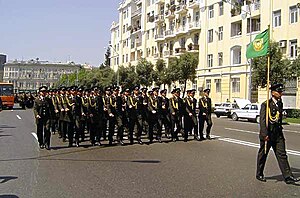Four Neighbors Campaign
This article is a work-in-progress because it is incomplete and pending further input from an author. Note: The contents of this article are not considered canonical and may be inaccurate. Please comment on this article's talk page to share your input, comments and questions. |
The Four Neighbors Campaign was the Nysdra Sea Treaty Association invasion of southern Algoquona during the Final War of the Deluge. The campaign was designed to liberate the four tribal nations directly neighboring New Yustona - the Honeoye, Canandaguia, Saranac, and Gowandis peoples - from the rule of Algoquona. The Campaign was the first operation of the Royal and Confederate Army, which was formed with the express intent of prosecuting the campaign as Urcea and NSTA committed its primary forces in the war against Varshan both in the Invasion of Cetsencalia and the Quetzenkel front.
| Four Neighbors Campaign | |||||||
|---|---|---|---|---|---|---|---|
| Part of the Final War of the Deluge | |||||||
 Honeoye soldiers parade in Cohocton following the liberation of the city | |||||||
| |||||||
| Belligerents | |||||||
|
Template:Country data New Yustona Support: |
| ||||||
| Commanders and leaders | |||||||
| Guillaume d'Agostino | Muzhen Muzmuz | ||||||
| Units involved | |||||||
| Royal and Confederate Army | Hierarchical Corps of National Defense | ||||||
| Strength | |||||||
| Approximately 43,000 | 50,000+ | ||||||
| Casualties and losses | |||||||
|
2,582 killed 8,401 wounded | Unknown, high | ||||||
Background
Tepetlcali Campaign
Port St. Charles
Summary of operations
Early skirmishes
Battle of Cohocton
On January 2nd, the Royal and Confederate Army crossed the border and defeated entrenched groups of militia defending approaches to the Honeoye city of Cohocton. Unlike most other battles in the Final War of the Deluge, the initial battles of the Campaign were largely unsupported infantry battles due the lack of equipment for the Royal and Confederate Army early in the campaign. Only Levantine units had significant armored and artillery capabilities, and these were held in reserve. The initial victories allowed the Royal and Confederate Army to begin a battle for Cohocton itself. Street-to-street urban warfare broke out, and the Royal and Confederate Army managed to secure the city following a week of fighting and with the support of local resistance fighters. On the morning of the 11th, the Algoquonan garrison was ejected from the city and "liberated units" of Honeoye forces of the Royal and Confederate Army paraded through the city, greeted by their fellow countrymen enthusiastically. Following the loss of the city, Algoquona-aligned forces conceded much of Honeoye territory and retreated to defensive positions in the far north of the Four Neighbors area.
"Wandering in the desert"
Following the victorious effort to take Cohocton, the Royal and Confederate Army divided its forces into five primary components. The primary component was the "Forward Component", comprised mostly of Confederal tribal infantry units and accompanied by most of the armor and artillery the Army had from Levantine units. The "Security Component" was comprised of typically "Liberated units" with some Levantine units, primarily for the purpose of defending Cohocton and garrisoning liberated territory. The "Frontier Component" was comprised largely of Levantine and tribal units for the purpose of securing additional territory, spreading out as far as possible while avoiding battles beyond the skirmish level. The "Scout Component" was made up entirely of Levantine units and featured both armored and mechanized infantry, and was responsible for reconaissance-in-force against Algoquonan forces as well as the destruction of isolated Algoquonan garrisons discovered by the Frontier Component. The final portion was the "Training Component", responsible for evaluating and retraining tribal and liberated units after the Battle of Cohocton as well as providing for the training and readiness of new recruits gathered from volunteers in Cohocton. The Training Component was comprised of roughly an equal number of all three parts of the Royal and Confederate Army.
The decision to split the Army was extremely controversial both within the Levantine press and among the tribal members of New Yustona, both of whom sought quick and decisive action to defeat Algoquona. Guillaume d'Agostino, commander of the Royal and Confederate Army, believed that the Army was not yet in a posiiton to launch a decisive breakthrough, and doing so prematurely might lead in the fracturing of the Army due to the still-considerable defense the Algoquonans were capable of. Criticism also focused on the extremely sluggish pace of the campaign, given that the Royal and Imperial Army managed to functionally destroy the entire Algoquonan regular army over the course of approximately a month during the Tepetlcali Campaign. In an interview with the Levantine Times Union, d'Agostino famously quipped that his critics "wanted Royal and Imperial Army results on an Algoquonan time table", referring to the lack of preparation his forces still had.
Battle of Harlaouga
On April 13th, the bulk of the northward advancing "Forward Component" of the Royal and Confederate Army in addition to elements sent by both the Training and Scout Components encountered the majority of remaining Algoquona-aligned militias in the Four Neighbors area infront of the village of Harlaouga, a Gowandis settlement. In what analysts called the "first, modern, combined arms battle of the campaign", tribal unit infantry routed the militia forces following an advance by Levantine armor (primarily SAV-11 tanks) and barrage by artillery. The victory at Harlaouga concluded the campaign by removing all Algoquona-aligned militia forces from the territory of the Four Neighbors. The battle also proved that the Royal and Confederate Army could fight a modern-style war, provided they had the equipment. The victory lead to further investment in the force by Urcea.